Jat Regiment


The Jat Regiment is an infantry regiment of the Indian Army, it is one of the longest serving and most decorated regiments of the Indian Army.[1] The regiment has won 19 battle honours between 1839 to 1947[2] and post independence 5 battle honours, eight Mahavir Chakra, eight Kirti Chakra, 32 Shaurya Chakras, 39 Vir Chakras and 170 Sena medals.[3] The motto of the regiment is Sangathan Wa Veerta which truly signifies a spirit of unity and valour.
Lieutenant James Francis Hewitt wrote that the "Jats, or Getae, have not degenerated from the military prowess of their forefathers".[4]
Jat Regiment - A Historical Overview
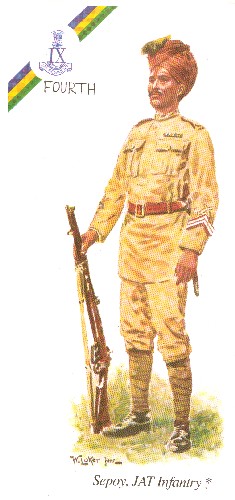



The Jat is the agriculturist par excellence and the quintessential soldier who dominates the area comprising the Punjab States, Sindh, Haryana, Jammu, Rajasthan, and Western Uttar Pradesh. Whether Hindu, Sikh, or Muslim he constitutes the most important peasantry in both India and Pakistan. But it is the Hindu Jat of Haryana, Western Uttar Pradesh and Rajasthan who concerns us since it is he who forms the bulk of the composition of the Jat Regiment, renowned for its valour and dour steadfastness in battle. Although so near to the seat of Mughal power in Delhi, the Jats managed to preserve a semblance of independence. Primarily tillers, they are rustic par excellence and as fighting men have established for themselves a reputation of being determined, sturdy, fierce and desperate fighters. Their background makes them simple, hard working, honest and loyal - the essential qualities of good soldiers.
History 1803 to 1947
The British in their quest for power and domination in India came into conflict with the Jats and recorded that they caused them the maximum trouble to subdue after the Sikhs. So impressed were they by the soldierly qualities of the Jats that they soon started recruiting them in ever-increasing numbers into all branches of the Bengal Army. The 1st Battalion was raised as the 22nd Bengal Native Infantry in 1803. The 2nd and 3rd Battalions were raised in 1817 and 1823 respectively. All three battalions had distinguished records of service including the winning of many honours during WW 1. The 1st Battalion in particular served with great distinction in France and Iraq (then Mesopotamia) and was conferred the signal honour of being declared "Royal" in addition to being made Light Infantry.
In the 1922 re-organization these Battalions along with the 18th Musalman Rajput Infantry were grouped together to form the 9th Jat Regiment with its class composition being fixed as 50% Jats from Punjab, 25% Punjabi Mussalmans from cis-Satluj States, Gujarat District and Ponchh District of J&K and Musalman Rajputs (Ranghars). World War 2 saw a large expansion in the ranks of the Regiment with a number of new battalions being raised. Owing to the large demands of manpower the Musalman Rajputs though still preferred were also augmented by the addition of Hindustani Mussalmans (Muslims from Haryana, UP, MP, Bihar, Rajasthan and the Deccan).
The Regiment saw a great deal of fighting with the Jats showing their mettle in North Africa, Ethiopia, Burma, Malaya, Singapore, and Java-Sumatra. A large number of gallantry awards were won including a Victoria Cross and two George Crosses. At the end of the war the Regiment, in company with other regiments of the Indian Infantry, dropped the numeral 9 from its title and became simply the Jat Regiment.
History 1947 to the Present
1947 saw the Regiment undergoing a great deal of change at last becoming a one-class Regiment of Jats, as it should have been from the beginning. The Punjabi Musalmans and Hindustani Mussalmans/Ranghars left for Pakistan being replaced by the Jats from the 15th Punjab Regiment, a Pakistan Regiment. Though 50% of the Regiment left for Pakistan and there were insufficient numbers of Jats to replace them someone in Army HQ had the foresight to give the Jats their due and make the Jat Regiment at last a true image of the proud yeoman peasantry it represented.
In free India the Jats maintained the high reputation they had created for themselves on the battle-fields of France and Flanders, Libya, Malaya and Burma to name a few. In Jammu and Kashmir 1947-48, the China War 1962, the conflicts with Pakistan in 1965 and 1971, and in Sri Lanka and Siachen, they have added to the laurels of the Regiment and the Army. Recently in the 1999 Kargil Conflict five of the Regiment's battalions took part and once again displayed the soldierly qualities that have made the Jats so well known in the community of fighting men. Earlier during the closing phase of the 1965 War with Pakistan a memorable night attack was launched by the 3rd Battalion and the tactically important hamlet of Dograi wrested from the enemy laying open the way to Lahore, Pakistan's second largest city and emotionally very close to them. The performance of the Regiment's Battalions during the UN missions in Korea and Congo has been in keeping with its high standards. Again, it performed very well in the Counter-Insurgency Operations that have kept the Indian Army busy ever since Independence. Nowadays it fights the foreign mercenaries in Kashmir with its traditional martial spirit.
Class Composition
The Jat Regiment's class composition is 100% Jats from Haryana, Rajasthan, Delhi, and Uttar Pradesh except for 3 Battalions whose ethnic make-up is as follows:
- 12th : All India All Class
- 15th : The AJGAR Battalion recruiting Ahirs, Jats, Gujars and Rajputs the classes with a common heritage. This was done as an experimental measure to test whether the mixing of these inter-linked classes could lead to fulfillment of the dream of a section of the politico-bureaucratic hierarchy; a mixed Army. This perception is shared by some of the Army’s top brass also.
- 20th : One of the Vaidya Battalions. Raised as an unthinking measure by Gen. Vaidya the then Army Chief after the events of 1984 with a mixed class composition of Jats, Dogras, Garhwalis, and Marathas.
The 9th Jat Regiment
The 9th JAT Regiment was a war famous elite-fighting Unit of the Jat Regiment. Many books have been written on the elite & famous 9th Jat Regiment including, War Services of the 9th Jat Regiment.
War Services of the 9th Jat Regiment by Lieutenant Colonel W.L. Hailes, is a historically famous publication detailing the military history of the Jat Regiment and of the Jat people. The publication details the military history & fighting prowess of the Jat Regiment & Jat people from 1893 to 1937.
The photo on the right is a WW1 (1914-1918) Jat Army Officer's Brass Button - from the famous 9th Jat Regiment.
Jat Regiment Heraldry & Honours
Battle Honours
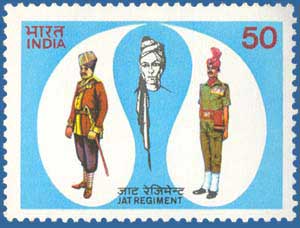
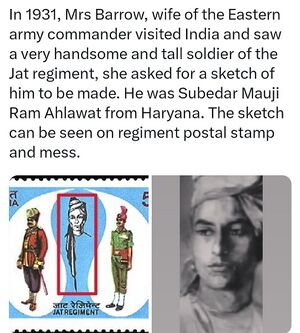
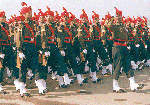
- Pre-1947
- Nagpur, Afghanistan (1839)
- Ghuznee, Ali Masjid, Candahar (1842)
- Cabool (1842)
- Maharajpore, Sobraon, Mooltan, Goojrat, Punjab, China (1858-9)
- Kandahar (1880)
- Burma (1885-87)
- Afghanistan (1879-80)
- China (1900)
- La Basee (1914)
- Festubert (1914-15)
- Shaiba, Ctesiphon, Khan Baghdadi, Kut al Amara (1915)
- Neuve Chappelle, France and Flanders (1914-15)
- Defence of Kut al Amara, Tigris (1916)
- Mesopotamia (1914-18)
- North West Frontier (India) (1914-15) (1917)
- Afghanistan (1919)
- Razabil, Kampar, Burma (1942-45)
- Jitra, Kanglatongbi, Malaya (1941-42) Ninshigum, The Muars, North Africa (1940-43)
- Post-1947
- Rajauri
- Zoji La
- Dograi (1965)
- Phillora (1965)
Unit Citations
Citations are given instead of Battle/Theatre Honours when a unit is decorated for Counter Insurgency Operations.
- 4th Battalion Nagaland 1995
- 7th Battalion J&K 1997
- 34th Battalion Rashtriya Rifles J&K 1997
- 17th Battalion Operation Vijay 1999 - Note: Operation Vijay was certainly not a CI operation, but because war was not declared between India and Pakistan, a Battle or Theatre honour could not be awarded.
Heraldry

Frankly, the Jat Regiment one of the premier regiments of the Indian Army has a rather uninspiring cap badge: the Roman numeral IX atop the Light Infantry bugle of the erstwhile 1st Battalion surmounted by the Ashoka Lions. This rather odd badge denotes the former seniority of the Regiment in the Army List. The Regiment never really got down to selecting an appropriate emblem for itself after Independence. A pity. The motto is 'Sanghatan aur Veerta' meaning Unity and Valour. The battle cry, adopted in 1955 is Jat Balwan Jai Bhagwan meaning that the Jat is Powerful, Victory be to God.
Victoria Cross Winners
- Jemadar Abdul Hafiz V.C. 9th Jat Regiment, awarded 6 April 1944, Burma.[6]
- Risaldar Badlu Singh V.C. 14th Murray's Jat Lancers attached 29th Lancers (Deccan Horse). Awarded 23 September 1918, Palestine (Posthumous).[7][8]
Maha Vir Chakra
- Captain Anuj Nayyar won a Maha Vir Chakra during the Kargil Conflict. He was an officer from the 17th battalion JAT Regiment.
The Regimental Center
The Regimental Centre was originally raised in July 1795 at Calcutta. Ever since the raising of the Regiment in 1922 the Regimental Centre has been located at Bareilly in Uttar Pradesh.
The Battalions

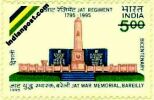
- 1 (Royal) Jat (LI) was originally raised in 1803 at Fatehgarh. It was affiliated to the Mechanized Infantry Regiment in 1980 and became its 2nd Battalion. Its class composition now is All India All Class. An article on 1 Jat (LI) in Sainik Samachar can be found here: http://mod.nic.in/samachar/nov1-03/html/ch8.htm
- 2nd Battalion (Mooltan) Raised at Bombay, October 1817. With the transfer of 1st Jats to the Mechanized Infantry Regiment in 1980, this is now the senior battalion.
- 3rd Battalion (Dograi) Raised 13 July 1847 at Dinapur.
- 4th Battalion (Asifwala) First raising July 1795 at Calcutta. Amalgamated with the 10th Training Battalion on 1 February 1922. Reraised 15 July 1940 at Jhelum. Lost after it surrendered at Singapore on 14 February 1942. Reraised 15 January 1962 at Bareilly. Served in Sri Lanka 4 Oct 1988 to June 1990.
- 5th Battalion (Ladakh) Raised 1 February 1941 at Banaras.
- 6th Battalion. Raised 1 February 1941 at Bareilly. Served in Siachen 1993-94.
- 7th Battalion. Raised 15 November 1962 at Bareilly.
- 8th Battalion (Poonchh) Raised 14 December 1959 at Bareilly.
- 9th Battalion (Chhamb) Raised 1 June 1962 at Bareilly.
- 11th Battalion. We have two contradictory raising dates for this battalion. The first is 1 April 1964 at Bareilly. The second is in 1968. Originally raised as 31 Jat as an "I Battalion on a special T/O for CI Ops in the North-East using specially selected personnel from the Jat Regiment, Sikh Regiment, Punjab Regiment, Dogra Regiment and Grenadiers. Converted to a standard infantry Battalion in 1972. Now has an All India All Class Composition. Served in Siachen 1988-89.
- 12th Battalion. Raised 7 June 1970 at Bareilly. Served in Sri Lanka 12th June 1988 to January 1990, and in Siachen 1998-99.
- 14th Battalion. Raised 1 October 1963 at Bareilly. Served in Sri Lanka 14 December 1987 to December 1989.
- 15th Battalion. Raised 15 May 1976 at Bareilly. Known as the AJGAR battalion.
- 16th Battalion. Raised 1 October 1964 at Bareilly. Served in Siachen 1990-91.
- 17th Battalion. Raised 1 June 1966 at Jabalpur.
- 18th Battalion. Raised 1 October 1966 at Secunderabad.
- 19th Battalion. Raised 1 August 1980 at Bareilly.
- 20th Battalion. The Jat Regiment's "Vaidya" Battalion was raised on 27 February 1985 with a mixed class company composition of Jats, Dogras, Garhwalis and Marathas. However, on 9 August 1998 orders were received for the re-organization of the Battalion as a 100% Jat unit. The following were the departures/arrivals: Departures: 1.Dogras to 19 Dogra 2.Garhwalis to 18 Garhwal Rifles. (This company, who proudly style themselves as the Garhwali Jats, took a stellar part in Operation Vijay, capturing Point 4700 and winning a number of gallantry awards.) 3.Marathas to the Maratha Light Infantry Regimental Center. Arrivals: 1.Jats from 18 Garhwal Rifles 2.Jats from 10 Madras 3.The fourth rifle company was raised from personnel sent from the Centre and other battalions. The re-organization of the 20th Battalion as a pure Jat unit was complete was completed on 31 December 1999. Served in Siachen 1989-90.
- 21st Battalion Raised 1 November 1987 at Bareilly. Served in Siachen 1991-92.
- 114 Battalion, Territorial Army. Raised 1 October 1960 at Dehra Doon.
- 5th Battalion Rashtriya Rifles. Raised 15 October 1990 at Ranikhet. This affiliated battalion gets 60% of its manpower from the Regiment.
- 34th Battalion Rashtriya Rifles. Raised 1 September 1994 at Bareilly. This affiliated battalion gets 60% of its manpower from the Regiment.
जाट रेजिमेन्ट के बारे में पाकिस्तान की राय
जाट नहीं होते तो क्या होता ?रिटायर्ड मेजर जनरल फैजल मुकीम खान ने अपनी पुस्तक ‘Pakistan Crisis In Command’ में लिखा है कि, भारतीय सेना का एक अभिन्न अंग होते हुए भी, भारतीय सेना जाटो के शौर्य से अंजान ही रही क्योंकि…..’घर की मुर्गी दाल बराबर !’भारतीय सेना को जाट की वीरता से कभी सीधा वास्ता नही पड़ा था ! दुश्मनों को पड़ा था और उन्होंने इनकी शौर्य गाथाएं भी लिखी! स्वयं पाकिस्तानी सेना के रिटायर्ड मेजर जनरल फैज़ल मुकीम खान ने अपनी पुस्तक ‘Pakistan Crisis In Command’ के पृष्ठ 250 पर, वे जाटो केसाथ हुई अपनी 1971 की मुठभेड़ पर लिखते हैं कि, “हमारी हार का मुख्य कारण था, हमारा जाटो से आमने सामने युद्ध करना! हम उनके आगे कुछ भी करने में असमर्थ थे! जाट बहुत बहादुर हैं और उनमें शहीद होने का एक विशेष जज्बा—एक महत्वाकांक्षा है! वे अत्यंत बहादुरी से लड़तेहैं और उनमें सामर्थ्य है कि अपने से कई गुना संख्या में अधिक सेना को भी वे परास्त कर सकते हैं!”वे आगे लिखते हैं कि……..‘3 दिसंबर 1971 को हमने अपनी पूर्ण क्षमता और दिलेरी के साथ अपने इन्फैंट्री ब्रिगेड के साथ भारतीय सेना पर हुसैनीवाला के समीप आक्रमण किया! हमारी इस ब्रिगेड में पाकिस्तान की लड़ाकू बलूच रेजिमेंट और पंजाब रेजिमेंट भी थीं ! और कुछ ही क्षणों में हमने भारतीय सेना के पाँव उखाड़ दिए और उन्हें काफी पीछे हटने के लिए मजबूर कर दिया । उनकी महत्वपूर्ण सुरक्षा चौकियां अब हमारे कब्ज़े में थीं । भारतीय सेना बड़ी तेजी से पीछे हट रही थीं और पाकिस्तानी सेना अत्यंत उत्साह के साथ बड़ी तेजी से आगे बढ रही थी! हमारी सेना अब कौसरे - हिंद पोस्ट के समीप पहुँच चुकी थी। भारतीय सेना की एक छोटी टुकड़ी वहां उस पोस्ट की सुरक्षा के लिए तैनात थी और इस टुकड़ी के सैनिक जाट रेजिमेंट से संबंधित थे!एक छोटी सी गिनती वाली जाट रेजिमेंट ने लोहे की दीवार बन कर हमारा रास्ता अवरुद्ध कर दिया ! उनहोंने हम पर भूखे शेरों की तरह और बाज़ की तेजी से आक्रमण किया! ये सभी सैनिक जाट थे! यहाँ एकआमने-सामने की, आर-पार की, सैनिक से सैनिक की लड़ाई हुई! इस आर-पार की लड़ाई में भी जाट सैनिकइतनी बेमिसाल बहादुरी से लड़े कि हमारी सारी महत्वाकांक्षाएं, हमारी सभी आशाएं धूमिल हो उठीं, हमारी उम्मीदों पर पानी फिर गया ! हमारे सभी सपने चकना चूर हो गये। [9]
जब 4-जाट रेजीमेंट ने बचाया था फाजिल्का
67 ब्रिगेड 2-जाट रेजिमेंट ने फाजिल्का में मनाया 1971 भारत-पाक युद्ध का विजय दिवस।
इस अवसर पर 550 कि.मी. बाइक रैली, ढाई कि.मी. लंबी विजय रैली, मैराथन प्रतियोगिता, देशभक्ति पूर्ण सांस्कृतिक कार्यक्रम, देश के लिए शहीद होने वाले परिवारों, जंग में लड़ाई लड़ने वाले जांबाज बहादुर पूर्व सैनिकों का भव्य सम्मान समारोह आयोजित किया गया। इस अवसर पर हजारों की संख्या में नागरिकों ने भाग लिया। रोहतक से जाट रेजीमेंट के विशेष निमंत्रण पर पधारे 1971 के महायोद्धा पूर्व कप्तान दिलबाग सिंह कादयान, सेना पदक विजेता, महापुरुष स्मृति परिषद के अध्यक्ष जसबीर सिंह मलिक, राष्ट्रीय जाट रत्न संपादक व महापुरुष स्मृति परिषद के राष्ट्रीय महासचिव राजबीर सिंह राज्यान का अभिनंदन सहित सम्मान किया गया। ज्ञात रहे कि जाट इतिहास लिखने में, नई खोजपूर्ण जानकारी देने में इनका महती योगदान रहा है।
इस अवसर पर पश्चिमी कमान के लेफ्टिनेंट जनरल दिनेश कुमार बिष्ट, ब्रिगेड कमांडर मनीष जैन, बीएसएफ के कमांडेंट, 2-जाट रेजीमेंट के सूबेदार मेजर जय सिंह सहित स्थानीय पंजाब के मंत्री अमन अरोड़ा, सांसद, विधायक सहित बड़े सैन्य अधिकारी ,हजारों सैनिक सहित शहर के गणमान्य नागरिक उपस्थित रहे। मुख्य कार्यक्रम पाक सीमा के समीप आसफवाला शहीदी स्मारक में सम्पन्न हुआ। रिट्रीट सेरेमनी के आयोजन में हजारों देश प्रेमी उपस्थित रहे। ज्ञात रहे कि बेरीवाला पुल ,गुरमुख खेड़ा गांव के मैदानी क्षेत्र में आमने सामने का 14 दिन-रात युद्ध चला, जिसमें भारतीय सेना के 232 जवान व अधिकारी शहीद हुए और पाकिस्तान के हजारों सैनिकों को मार गिराया था। 4-जाट रेजीमेंट, 3-आसाम रायफल, 15 राजपूत बटालियन की अगुवाई में यह युद्ध लड़ा गया और 14 दिन बड़ी जीत मिली। पाकिस्तान ने आत्मसमर्पण कर दिया। शहीदों का सामूहिक रूप से 90/18 फुट की चिता में राजकीय सम्मान के साथ दाह संस्कार किया गया।
52 वर्षों से हर साल 16/17 दिसंबर को विजय दिवस यहां मनाया जाता है। तब से शहीदों की समाधि पर यादगार कमेटी द्वारा आसफवाला में किया जा रहा है। आज भी 1971 के स्थानीय बुजुर्ग लोग 4-जाट रेजीमेंट की विजय गाथा गाते हुए कहते हैं कि अगर 4-जाट रेजीमेंट नहीं होती तो आज फाजिल्का पाकिस्तान में होता।
- ऐसे जंग के जांबाजों को हमारा शत शत नमन।।
- द्वारा: महापुरुष स्मृति परिषद 9355675622
- (Posted at a Whatsapp group on 22 December 2023)
Thanks to
- Mandeep S. Bajwa & Ravi Rikhye.
- Thanks to Ravi Rikhye at Center for Indian Military History.
External links
- Jat Regiment @ IndianMilitaryHistory.org - For some more excellent info about the Jat regiment and the Indian Army.
- Jat Regiment on Bharat-Rakshak
- An article on Jat Regiment at cowbird.com
- जाट रेजीमेंट की बहादुरी एक अंग्रेज़ की जुबानी
Gallery
-
Jat Regiment World War 2 Postal Card, European Elite Ladies pick this painted photo of Jat Soldier and issued Postal Cards to honor and pay respect.
-
Jat Regiment World War 2 Postal Card back
-
अमर उजाला, मंगलवार , 1 सितम्बर 2020
-
-
References
- ↑ http://www.india-defence.com/reports/2849
- ↑ http://www.bharat-rakshak.com/MONITOR/ISSUE3-4/bajwa.html
- ↑ http://www.india-defence.com/reports/2849
- ↑ Hewitt, J. F. (1894). The Ruling Races of Prehistoric Times in India, Southwestern Asia, and Southern Europe. Archibald Constable & Co., London. p. 482.
- ↑ [1]
- ↑ We Were There - Medals and Awards - Victoria Cross Winners
- ↑ Risaldar Badlu Singh, VC
- ↑ We Were There - Medals and Awards - Victoria Cross Winners
- ↑ abairad36<abairad36@gmail.com>
Back to People






